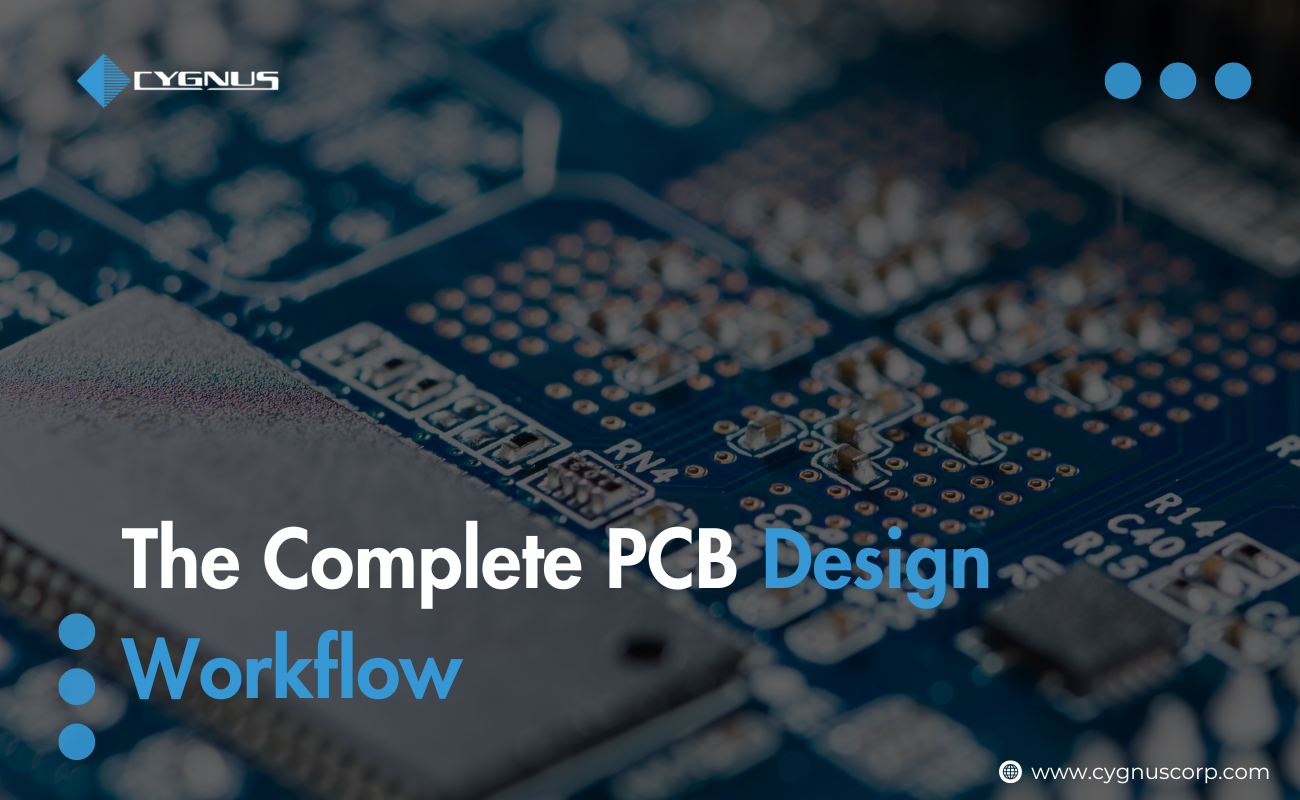In the midst of an electronics renaissance, the significance of printed circuit boards (PCBs) has never been more pronounced. As the backbone of nearly all electronic devices, the global PCB market is expected to surge, reaching $86.17 billion by 2026, reflecting a steady growth in demand across various sectors.
This blog will take you through the complete PCB design workflow, detailing each phase from conception to the final product deployment, with insights into the processes that ensure these crucial components meet the high standards required for advanced electronic applications. Join us as we navigate the intricate journey of PCB design, a critical element at the heart of modern technology’s expansion and sophistication.
Conceptualization:
The first stage in the complete PCB design workflow is conceptualization. Here, the idea for a PCB begins to take shape based on the needs of the project, defining the circuit’s functionality and performance requirements. This phase is about brainstorming and outlining the primary objectives of the PCB, including its operational environment and user interaction. Latest trends in the market, such as the increasing demand for smaller, faster, and more energy-efficient components, significantly influence the design concept.
Schematic Design:
In the schematic design phase of the PCB design process, electronic diagrams representing the circuit are created. These schematics serve as a blueprint for the PCB and detail every component and their connections. This step involves selecting components, such as resistors, capacitors, and integrated circuits, based on their electrical properties and availability, ensuring the PCB design basics are thoroughly adhered to for effective function and manufacturability.
PCB Layout Design:
Following the schematics, the PCB layout design begins. This is where the physical manifestation of the circuit takes form. Designers place components on the board and route electrical connections between them. The layout must consider physical constraints and electromagnetic compatibility. An effective PCB design flow includes software tools that help optimize the space and minimize signal interference, crucial for maintaining the integrity of high-speed signals.
Simulation and Testing:
Before moving to prototyping, the design undergoes simulation and testing to predict how it will perform in the real world. This stage of the PCB design workflow helps identify any potential issues with circuit behavior, thermal stress, and electromagnetic interference. Utilizing sophisticated software, engineers can make adjustments early in the process, saving costs and time by reducing the number of physical prototypes needed.
Creating Prototypes:
Once simulations validate the design, prototype creation begins. This is a critical step in the PCB manufacturing process, allowing designers and engineers to test the physical product under actual operating conditions. Prototyping helps validate the design further, test the functionality, and gather feedback for refinements. The rate of innovation in PCB materials and technologies, such as flexible PCBs, has accelerated prototyping capabilities, making it quicker and less expensive.
Final Design Review and Iteration:
The final design review and iteration process ensures that the PCB meets all specifications and requirements set during the conceptualization phase. This stage might cycle through several iterations based on feedback from the prototype testing. Here, the design is fine-tuned for manufacturability in an effective PCB design flow, ensuring that the final product will be reliable and producible at scale.
Manufacturing:
With the final design approved, the PCB manufacturing process begins. This involves the actual creation of the PCB, which includes the fabrication of the board itself and the application of various chemical and physical processes. As of recent statistics, the use of automation and advanced manufacturing technologies has significantly streamlined this process, enhancing precision and reducing waste.
Assembly and Production:
During assembly and production, the components are mounted onto the PCB. This can be done through various techniques such as surface-mount technology (SMT) or through-hole technology. Modern assembly lines are highly automated and can place and solder thousands of components per hour with high precision, integral to maintaining consistency and quality in mass production.
Testing and Deployment:
Post-assembly, the PCBs undergo rigorous testing to ensure they meet operational standards and perform according to specifications. This includes functional tests to simulate operating conditions and in-circuit tests to check for proper component functioning. Once verified, the PCBs are deployed into their respective products or systems.
Maintenance and Updates:
The final phase in the PCB design workflow is maintenance and updates. As technologies and customer needs evolve, PCBs may require updates or revisions. This ongoing process ensures the longevity and relevance of the PCB in its application, accommodating new features or improvements in efficiency as required by the market or technological advancements.
Each of these stages in the complete PCB design workflow is crucial for the successful creation and implementation of PCBs in various applications, reflecting the dynamic nature of this field in response to technological progress and market demands.
Conclusion:
As we conclude our exploration of the complete PCB design workflow, it’s clear that mastering the PCB design process involves much more than simply laying out components on a board. From the initial conceptualization to the final deployment, each phase is integral to ensuring that the finished PCB stands up to the demands of modern technology.
Understanding the PCB design basics and incorporating an effective PCB design flow are essential for creating reliable, efficient, and cost-effective electronic components. This comprehensive journey through the PCB design workflow not only highlights the complexity and sophistication of electronic manufacturing but also underscores the relentless progression of technology that drives us forward.
FAQs
What software tools are essential for PCB design?
Essential software tools for PCB design include CAD (Computer-Aided Design) programs like Altium Designer, Eagle, and KiCad, which facilitate schematic capture, PCB layout, and simulation.
How do you ensure the quality of a PCB design?
Quality in PCB design is ensured through rigorous testing and simulation, adherence to design standards, and review processes that check for errors and compliance with technical specifications.
What are the most common challenges in PCB design and how can they be addressed?
Common challenges include managing signal integrity, thermal management, and component placement. These can be addressed by using advanced simulation tools, careful planning of layout, and adherence to best practice design principles.
Can PCB design be optimized for cost-effective manufacturing?
Yes, PCB design can be optimized for cost-effective manufacturing by minimizing the use of different materials, reducing the board size, and simplifying the design to use fewer layers and standard components.




